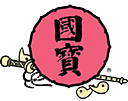ORIGINS OF OUR TRADEMARKS
We are often asked about the significance and origins of two of our well known trademarks, Kokuho Rose and Sho-Chiku-Bai.
Kokuho Rose®

The legend of the Three Sacred Treasures has ancient roots in Japanese creation mythology. The eight-sided mirror (pink "shield" in our logo) symbolizes self-reflection and the heavenly sword represents strength and sharpness in knowledge and decision. Comma shaped jewels express dual meanings of amiability on the spiritual level and prosperity on the secular.
Based upon this legend, Keisaburo Koda designed the Kokuho Rose logo honoring his family's cultural heritage incorporating cultural motifs Japanese Americans (of his relative generation) could readily identify. In the center of the pink "mirror", Keisaburo superimposed Kanji characters of "Kokuho" ("treasure of the Country"). The word “Rose” was arbitrarily added, being in fashion with current branding of other domestic rice and grain products.
In continuous use since 1962, Kokuho Rose is the trademark and property of Koda Farms, which alone produces the pure and proprietary strain of this rice. Historically farmed in very limited quantities, permission was granted to Nomura and Co., Inc. to utilize this trademark on their own variety of rice (essentially a "modern descendent" of our heirloom Kokuho Rose) which they produce in northern California. To this day, two versions of Kokuho Rose co-exist in the marketplace.
Sho-Chiku-Bai ®

The association of pine, bamboo, and plum is a recurring motif in Asian cultures. Because of their ability to survive the harsh winter months, these plants symbolize strength in the face of adversity. In Chinese and Japanese art and literature, the trio is collectively known as the "Three Friends of Winter".
Introduced in 1948, the Sho-Chiku-Bai logo was also developed under the direction of Keisaburo Koda. The red plum's five petal flower serves as the main body of the logo on which the green bamboo and stylized pine are overlaid. Central to the logo is the white Kagami Mochi. A traditional New Year’s decoration appearing in private and public settings, it is composed of two sweet rice "cakes", differing in size and stacked one atop the other.